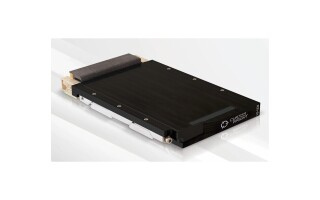Miniaturizing electronic warfare microelectronics to advance precision-guided weapon technologies
StoryNovember 07, 2017
Electronic warfare (EW) technologies are normally deployed in ground, naval, and airborne platforms to maintain a strategic and tactical advantage in the modern battlefield. As the threat environment evolves, there is an increasing need to integrate sophisticated EW capability into precision-guided weapons (PGW). These platforms present the most demanding size, weight, and power (SWaP) challenges for the defense microelectronics industry today. Recent technology developments have yielded high-performance, miniaturized and ruggedized RF components and modules for these SWaP-constrained EW systems.
Electronic warfare technologies, normally deployed in ground, naval, and airborne platforms, provide a strategic and tactical advantage in the modern battlefield. At the same time, modern military forces continue to transition from conventional weapons to precision-guided munitions and missiles with enhanced strike capabilities. In response, adversaries are turning to electronic attack technologies to disrupt the navigation and guidance systems of precision guided weapons (PGW), thereby reducing their efficacy to that of conventional weapons used in the first half of the 20th century. To counter this emerging electronic-attack threat, electronic protection microelectronics from ground, naval, and air platforms must be adapted and greatly miniaturized in a form factor sufficiently compact and ruggedized for PGW. Achieving this goal requires a fundamental shift in perspective on digital RF memory (DRFM) design methodology to embed EW technology in the extremely space-constrained environment allocated for microelectronics in modern PGW.
These highly miniaturized modules, small enough to fit in the palm of a hand, are ideal for applications where conventional DRFM capabilities are too large for consideration in missiles and precision-guided munitions.
Rethinking RF in DRFMs
The analog componentry of a typical DRFM design occupies the majority of the allocated design space; a miniature DRFM can only be realized with significant attention to shrinking the analog circuitry while simultaneously delivering the enhanced ruggedization needed to withstand the harshest expected operating conditions. Operating conditions can vary widely based on the munition and its specific profile. The DRFM module must be designed to withstand any combination of high-frequency mechanical vibration, rapid acceleration during launch, extremes in thermal shock, and exposure to moisture, salt water, or corrosive environments. Addressing one of these challenges alone is a complex task; addressing all of them simultaneously requires the DRFM architect to completely rethink the approach to analog circuitry design. An appropriately designed multichip module (MCM) is a practical example of how both of these requirements can be achieved simultaneously. An example of such a MCM device, where miniaturization by a factor of more than three has been achieved, is shown in Figure 1.
Figure 1: RF MCM allowing simultaneous miniaturization and ruggedization of analog circuitry for DRFM applications. Illustration courtesy Mercury Systems.
On the bottom of the RF MCM device is a ball grid array (BGA) where solder balls carry power and required signals through the selected printed circuit board (PCB). The PCB material was carefully chosen to balance mechanical integrity and heat dissipation given the severe space constraints of the application. Where possible, bare die components were selected to maximize circuit miniaturization. However, this choice has consequences in terms of increased cost and reduced manufacturability. The latter can be largely overcome using engineering resources highly skilled in design-for-manufacturability principles. Even in the best-case scenario, however, not all components can be integrated as bare die. Hybrid manufacturing techniques are required to produce high-reliability MCM devices.
Ruggedizing digital components
The digital processing components of DRFM modules are far fewer in number and present fewer opportunities for miniaturization than the RF circuitry. The dimensions of the digital processing elements are restricted by the available packaging of commercial components. One area in which designers can take advantage of three-dimensional packaging techniques is by reducing the two-dimensional footprint of a planar array of DRAM modules, up to 75 percent in high-speed DDR4 memory modules. When embedded into a single BGA device, the resulting package delivers proven reliability benefits in extreme environmental conditions. Advanced three-dimensional packaging technologies using through-silicon vias offer the promise of further SWaP enhancements, but the technology has not yet achieved maturity levels sufficient to address the demanding thermal and mechanical requirements of the military market.
DRFM design for use case
Designers of DRFM modules used in less space-constrained environments view their design space as a two-dimensional plane, often with little attention paid to the third dimension. A miniaturized DRFM for a PGW, however, has such severe space constraints that all available volume must be considered as viable design space. Vertical stacking and interconnection of multiple printed circuit boards enables near complete utilization of all physical space available, as shown in Figure 2. However, in such cramped quarters, designers must now consider board-to-board signal interaction while ensuring sufficient mechanical integrity for the overall electronics package.
As DRFM microelectronic components are allocated to individual printed circuit boards for vertical stacking, the concept of modularity becomes important. Maximum space efficiency is achieved if components serving a common functionality are used on the same board. For example, all digital components have been placed on a single board in Figure 2 while the analog circuitry is colocated on a separate board. Modularity, however, offers other benefits. The separation of digital processing from the noise-sensitive RF circuitry naturally enables higher performance of the entire sensor chain. Additionally, if performance-limiting components – such as analog-to-digital converters (ADCs) or a field-programmable gate array (FPGA) – are updated by the manufacturer, modularity enables rapid upgrade cycles while reusing boards not affected by the design change. Furthermore, modularity enables early detection and resolution of manufacturing anomalies that would otherwise go undetected until final test of the fully assembled DRFM.
Figure 2: Conventional DRFM device (left) with analog and digital components on the same two-dimensional plane, compared to miniaturized DRFM (right) using three-dimensional stacking of modular boards. Illustration courtesy Mercury Systems.
Space constraints and mission profiles will determine what trade-offs need to be made in the design to optimize overall system performance. For example, higher dynamic range can be realized, if required for the mission, by slightly enlarging the form factor of the stacked DRFM module; the resulting larger form factor is then better suited to address the heat dissipation requirement associated with the higher power levels required to enable the increased dynamic range.
Unlike conventional DRFM modules, which are expected to have lifetimes of many years, DRFM modules custom-engineered for PGW are in operational use for minutes and destroyed with a successful mission. Because of this extremely short operating life, DRFMs for PGW can operate at very high power levels – far beyond that of a conventionally designed and operated DRFM – thereby delivering effective electronic protection capability during the weapon’s short flight. This high-power requirement complicates the overall system power supply requirements, as the digital circuitry requires a low operating voltage. The DRFM system power supply therefore must operate at high current and low voltage, with very low noise levels.
21st-century precision-guided weapons
The microelectronics content of weapons systems must continue to increase, both in RF performance and in processing complexity, to address the evolution of the modern threat environment. Miniaturization and ruggedization of microelectronics is no longer sufficient; microelectronics must be purpose-built for real-life use case scenarios with an eye towards modularity and overall system optimization.
Maintaining a strategic and tactical advantage requires the defense community to continue embracing commercial technology advances while deploying innovative and upgradeable microelectronics platforms.
Charlie Hudnall is vice president and general manager of the Embedded Sensor Processing group and Chief Technologist of the Advanced Microelectronics Systems group at Mercury Systems in Huntsville, Alabama. Charlie has a Bachelor of Science degree from Mississippi State University in Computer Engineering and a master’s degree in electrical engineering from Southern Methodist University. He can be contacted at [email protected]. Philip Fulmer is director of product marketing for the Advanced Microelectronics Solutions group at Mercury Systems in San Jose, California. Philip has a Bachelor of Science degree in Chemistry from the University of Scranton and a master’s degree in Material Science and Engineering from the University of Texas at Austin. He can be contacted at [email protected].
Mercury Systems • www.mrcy.com








